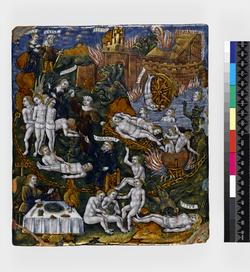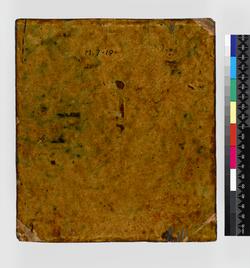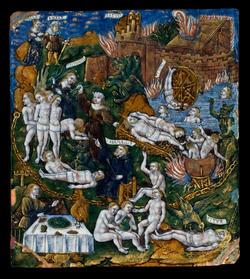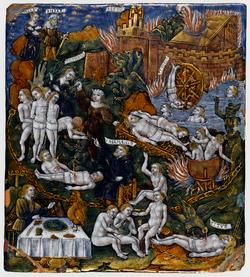Current Location: Gallery 32 (Rothschild)
Titles
Aeneas and the Sybil in the Underworld
Maker(s)
Enameller:
The Master of the Aeneid Series
Entities
Categories
Description
Copper, enamelled in polychrome and gilded with a scene showing Aeneas and the Cumaean Sybil in the Underworld.
Slightly convex copper plaque, enamelled in translucent greyish-blue, dark blue, green, mulberry-brown and clear appearing tan, and in semi-translucent pinkish-red, and opaque white and profusely gilded. There is a white preparation under the areas enamelled in greyish-blue, white and pale red. The drawing appears black on the copper or the white preparation. The translucent colours are applied directly over the copper (clearly visible where there is loss of enamel on the edge and elsewhere under magnification). Water is represented by a thin wash of translucent greyish-blue over the dark and white layers with enlevage to produce black wavy lines. The reverse has brownish translucent counter-enamel, tinged here and there with green.
The Cumaean Sybil, labelled '(SY)BILLA', and Aeneas, labelled 'ENEAS', stand in the top left corner. At top centre is a label 'I.ET.VII' beside the bell-tower of a flaming tripple-walled castle with a green many-headed Hydra guarding its gates which occupies the top left corner.Outside the walls there is a man bound to a waterwheel, and three men's heads emerging from a mill pond. On the wall above the wheel is a label inscribed 'TI.ION' (?ILION - Troy). Below Aeneas is a label inscribed 'TISIPHONE' beneath which she and another Fury holding snakes, are beating four almost nude men bound to a tree, and another man who leans forward over a devil who is stabbing two men lying on the ground. Below to the right are two men prone, one upwards and one downwards, on a bed of nails, and further to the right, three being cooked in a cauldron attended by a green devil. In the middle, Rhadamanthus, labelled 'FASAMANI9', robed and holding a sceptre, sits on a stool, and behind him on the ground, is a seated man with his right arm raised. A gold chain divides these figures from those below. In the lower left corner, a young man is seated at a table covered by a white cloth and laid for a meal. A bird with a female head stands opposite to him on the table. In the middle three men are seated on the ground , two of them holding a jug. In the lower right corner is a label inscribed 'TITVS' over a vulture which is pecking the thorax of Tityus, who is encircled by a gold chain. Gold is used lavishly for the hair of the figures, outlining of features, and shading.
Notes
History note: Possibly a late 18th century sale in Amsterdam; unidentified owner; H. Wareham Harding, London, from whom purchased by the Friends of the Fitzwilliam Museum
Legal notes
Given by the Friends of the Fitzwilliam Museum
Measurements and weight
Height: 22.4 cm
Width: 20 cm
Acquisition and important dates
Method of acquisition: Given
(1945-06-15)
by
The Friends of the Fitzwilliam Museum
Dating
16th Century, second quarter
François I
Circa
1527
CE
-
1530
CE
Note
This is one of a series of eighty-three recorded plaques each decorated with a different scene after the woodcut illustrations to Books I to IX of the Aeneid in Sebastian Brandt's edition of Virgil's 'Opera', printed by Johann Grüninger in Strasburg in 1502 (a copy is in the Cambridge University Library, Tb.51.61). Or, possibly, from editions with the same woodcuts published at Lyon by Jacob Saccon in 1517 and by Jean Crespin in 1529. The series was probably the earliest example of classical subjects on Limoges enamels, and was the largest group of plaques with a coherent theme derived from the same source. The subject on this plaque is from Book VI, and was copied from the woodcut which appears on fol. 274 recto of the 1502 edition. It shows Aeneas with the Cumaen Sibyl who was guiding him through the Underworld to see his father, Anchises, when they reached a point where the path divided, one branch leading to Elysium, and the other to Tartarus where various souls are being judged and tormented. For listings of the other Aeneid plaques, see Documentation.
The iconography follows Vergil's description, but Pirithoüs, the King of the Lapiths (lower left corner), who was unable to move after sitting down in the Underworld, appears more like Tantalus, who was usually assigned the punishment of being surrounded by food and drink but unable to assuage his thirst or hunger. Below the city walls (top right), the figure tied to a wheel is probably Ixion who was crucified on a wheel by Zeus as punishment for attempting to rape Hera. The enameller did not follow the woodcut exactly. The entrails and liver of Tityus (lower right corner) are not shown as they are in the woodcut. The anatomy of the almost nude figures is more rounded and realistic, and the Fury, Tisiphone, wears a small crown instead of a cap.
Neither the patron nor the original situation of the plaques has been discovered. It seems possible that they were set into the panelling in a collector's cabinet or study, as in the often cited ‘cabinet des émaulx’ in Catherine de Medici’s, hôtel in the rue de Grenelle, Paris, where the inventory after her decease mentioned ‘Trent neuf petit tableau d’émail de Limoges en form ovale enchassez dans le lambris au dict cabinet’.
The Master of the Aeneid Plaques has remained an enigma, although some scholars have considered that he might have been Jean I Pénicaud. Very few other enamels have been attributed to him on the basis of features which occur in the Aeneid plaques, such as a distinctive way of rendering clouds. These including a Crucifixion after Lucas van Leyden in the Victoria & Albert Museum inv. no. 2820-1926, a Crucifixion after Dürer. formerly in the Givenchy Collection (see Documention, Descheemaecker), and an Adoration of the Magi acquired by the Musée municipal de l’Évêché, Limoges in 2006, which has a leaf of silver over the entire surface beneath the enamelling.
School or Style
Renaissance
People, subjects and objects depicted
Components of the work
Decoration
composed of
enamels
( translucent greyish-blue, dark blue, green, mulberry-brown and clear appearing tan, and in semi-translucent pinkish-red, and opaque white; clear counter enamel)
gold
Plaque
composed of
copper
Inscription or legends present
Inscription present: first two letters of name are missing
- Text: (SY)BILLA
- Location: On front
- Method of creation: Painted in black enamel
- Type: Inscription
- Text: ENEAS
- Location: On front
- Method of creation: Painted in black enamel
- Text: I·ET·VII
- Location: On front, top centre
- Method of creation: Painted in black enamel
- Type: Inscription
- Text: TI·ION
- Location: On front
- Method of creation: Painted in black enamel
- Type: Inscription
- Text: TISIPHONE
- Location: On front
- Method of creation: Painted in black enamel
- Type: Inscription
- Text: SALMONE
- Location: On front
- Method of creation: Painted in black enamel
- Type: Inscription
- Text: FASAMANI9
- Location: On front
- Method of creation: Painted in black enamel
- Type: Inscription
- Text: TITVS
- Location: On front
- Method of creation: Painted in black enamel
- Type: Inscription
References and bibliographic entries
-
Friends of the Fitzwilliam Museum, Thirty-seventh Annual Report, for the Year 1945
page(s): 1, 3
-
Maleremails aus Limoges, Der Bestand des Berliner Kunstgewerbemuseums
page(s): 54
-
La série de plaques du Maître de L'Éneide
page(s): 133-48
-
Treasures of the Fitzwilliam Museum
page(s): 136
-
Sebastian Brandt and the First Illustrated Edition of Vergil
page(s): 187-99
-
Notice d'une collection d'émaux peints par les célèbres maïtres, et formée par les soins de M. d’Hancarville, don’t la vente s’en fera le 10 mai 1791
-
The Walters Art Gallery, Catalogue of the Painted Enamels of the Renaissance
page(s): 76-89
-
The Waddeston Bequest, The Legacy of Baron Ferdinand Rothschild to the British Museum
page(s): 42-3
-
Important European Sculpture and Works of Art
page(s): 17
-
The Keir Collection of Medieval Works of Art
page(s): 251
-
Attributions to the Aeneid Master
page(s): 370-5
-
Old Master Sculpture and Works of Art
-
Emaux de Limoges de la Renaissance provenant de la collection de M. Hubert de Givenchy
-
Les acquisitions du musée municipal de l’Évêché de Limoges, 2006
-
Treasures including Selected Works from the Collections of the Dukes of Northumberland
-
Virgilian Identities in the French Renaissance
page(s): 161-88
-
The Exceptional Sale
-
Old Master Sculpture and Works of Art
-
Mobilier et objets d'art, tableaux anciens et modernes, haute époque, art d'Asie
Identification numbers
Accession number: M.7-1945
Primary reference Number: 118320
Stable URI
Audit data
Created: Saturday 6 August 2011
Updated: Tuesday 30 April 2024
Last processed: Thursday 14 August 2025
Associated departments & institutions
Owner or interested party:
The Fitzwilliam Museum
Associated department:
Applied Arts
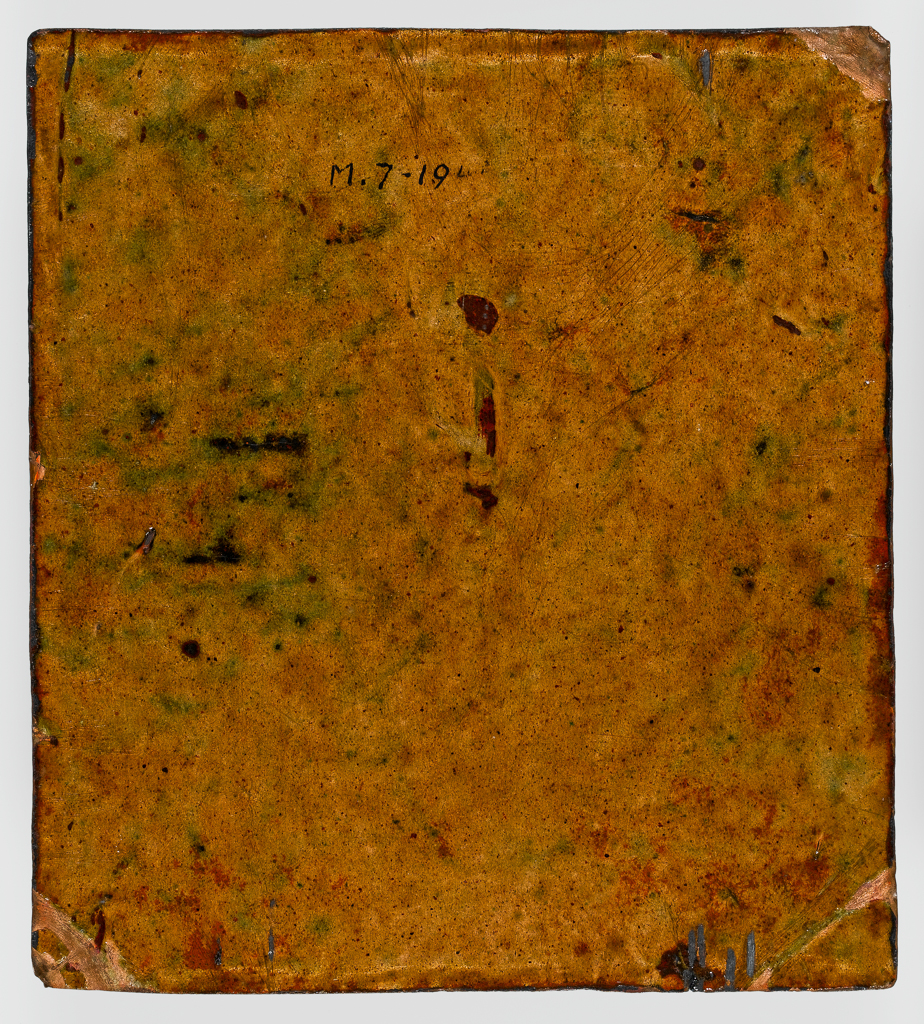
 IIIF Manifest
IIIF Manifest
